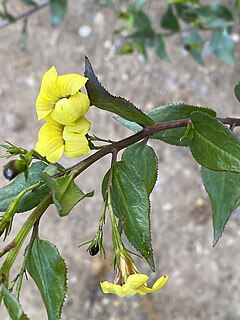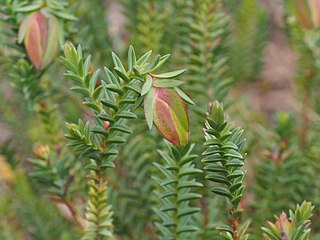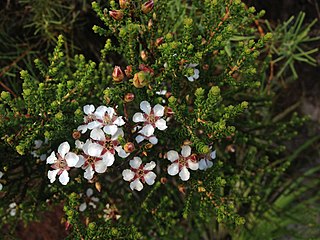
Darwinia, sometimes commonly known as mountain bells or simply bells, is a genus of about 70 species of evergreen shrubs in the family Myrtaceae, endemic to southeastern and southwestern Australia. The majority are native to southern Western Australia, but a few species occur in South Australia, New South Wales and Victoria. The genus was named in honour of Erasmus Darwin, grandfather of Charles Darwin by Edward Rudge in 1816. Most darwinias grow to a height of between 0.2 and 3 m, and many are prostrate shrubs. Most have small, simple leaves and the flowers are often grouped together, each flower with five red, white or greenish petals and ten stamens. In many species, the flowers are surrounded by large, colourful bracts, giving rise to their common names.

Goodenia ovata, commonly called the hop goodenia, is a species of flowering plant and is endemic to south-eastern Australia. It is a shrub with sticky, often varnished foliage, toothed egg-shaped to elliptic leaves and racemes or thyrses of yellow flowers.

Darwinia glaucophylla is a plant in the myrtle family Myrtaceae which grows as a prostrate shrub, sometimes forming extensive mats. It has bluish green leaves and white flowers in small groups which fade to reddish pink as they age. It is only known from about fifteen sites in the Gosford area and is listed as "threatened" in New South Wales legislation.

Darwinia fascicularis is shrub in the myrtle family and is endemic to areas near Sydney. A small shrub with aromatic foliage and white flowers, turning red as they mature. Nectar feeding birds are attracted to its flowers as a food source.

Persoonia bargoensis, commonly known as the Bargo geebung, is a species of flowering plant in the family Proteaceae and is endemic to a restricted area of New South Wales. It is an erect shrub with linear to lance-shaped leaves, yellow, tube-shaped flowers and green, pear-shaped fruit.

Leucopogon amplexicaulis, commonly known as beard-heath, is a species of flowering plant in the heath family Ericaceae and is endemic to eastern New South Wales. It is a scrambling or straggly shrub with egg-shaped, stem-clasping leaves with hairy edges, and spikes of small white flowers.

Homoranthus darwinioides, commonly known as fairy bells, is a species of flowering plant in the family, Myrtaceae. It is a small, spreading shrub with pendulous yellow and pink flowers, grey-green leaves and is endemic to New South Wales.

Darwinia briggsiae is a plant in the myrtle family Myrtaceae and is endemic to New South Wales. It is an erect shrub with linear-shaped leaves and small groups of pink and white flowers.

Styphelia viridis, commonly called green five corners, is a plant in the family Ericaceae and is endemic to the east coast of Australia. It owes its common name to the appearance of its fruit - a drupe with a flat top and five distinct ribs, and to the colour of its flowers. The flowers appear in autumn and winter and are a source of food for honeyeaters.

Darwinia camptostylis is a plant in the myrtle family Myrtaceae and is endemic to New South Wales and Victoria. It is small shrub with flattened, glabrous leaves and small clusters of green to yellow flowers. There are scattered populations in coastal areas where the plants grow in heath.

Darwinia capitellata is a plant in the myrtle family Myrtaceae and is endemic to the south-west of Western Australia. It is a bushy, many-branched shrub, very similar to Darwinia diosmoides but differs in the arrangement of its flowers, its more branched habit, prominent oil glands on the younger stems and its thinner, paper-like bracteoles. It was first discovered as a separate species when specimens of it were found to have a larger chromosome number than specimens of D. diosmoides.

Darwinia carnea, commonly known as Mogumber bell or Narrogin bell is a plant in the myrtle family Myrtaceae and is endemic to the south-west of Western Australia. It is a small shrub with narrow, keeled leaves and flowers in groups of about eight, surrounded by yellowish-green to pinkish-red bracteoles. It occurs in small, isolated populations near the towns which contribute to its common names. It is the only "bell-flowered" Darwinia to not grow in the Stirling Range National Park.

Darwinia procera is a plant in the myrtle family Myrtaceae and is endemic to a small area in New South Wales. It is a shrub with laterally compressed leaves, so that they are thicker than wide. The flowers are reddish-purple and arranged in groups of four near the ends of the branches. Although rare in nature, this species is often grown by native plant enthusiasts.
Darwinia ferricola, commonly known as the Scott River darwinia, is a plant in the myrtle family Myrtaceae and is endemic to a small area in Western Australia. It is a rounded, densely branched shrub with crowded, linear leaves mostly only on younger branches. The flowers are greenish-yellow and red, and arranged in groups on the ends of the branches, with a long white or reddish style protruding from the petal tube.

Darwinia peduncularis is a species of flowering plant in the myrtle family Myrtaceae and is endemic to the Sydney region in New South Wales. It is a shrub with flattened leaves and purplish red flowers usually arranged in pairs.

Homoranthus biflorus is a flowering plant in the family Myrtaceae and is endemic to a small area in northern New South Wales. It is an erect shrub with cylinder-shaped leaves and small groups of usually yellow flowers.

Homoranthus virgatus commonly known as twiggy homoranthus, is a species of flowering plant in the family Myrtaceae and is found growing in coastal areas of northern New South Wales and in Queensland. It is an upright shrub with wand-like branches, aromatic foliage and white to pink flowers in small clusters at the end of branches.

Bossiaea stephensonii is a species of flowering plant in the family Fabaceae and is endemic to near-coastal areas of New South Wales. It is a small, weakly erect, multi-stemmed shrub with sharply-pointed, mostly elliptic to egg-shaped leaves, and bright yellow and red flowers.

Leptospermum epacridoideum is a species of plant that is endemic to a restricted area of the South Coast of New South Wales. It is a bushy shrub with compact bark, elliptical to more or less circular leaves, white flowers arranged singly on short axillary side shoots, and woody fruit.

Leucopogon clelandii, commonly known as Cleland's bearded-heath, is a species of flowering plant in the heath family Ericaceae and is endemic to the south-east of continental Australia. It is weak, open shrub with broadly egg-shaped leaves and white flowers arranged singly or in pairs in leaf axils near the ends of the branches.




















